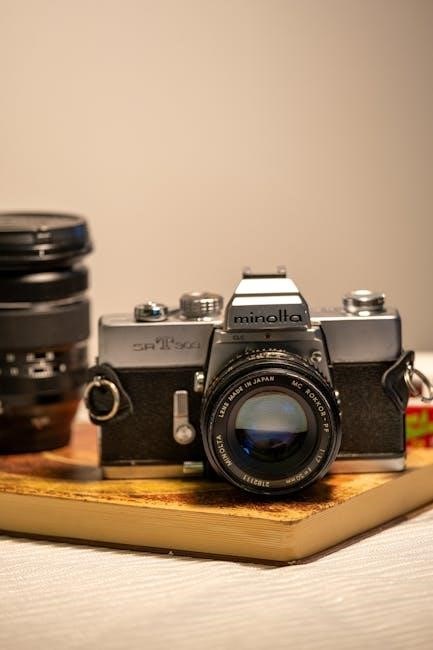Minolta X-370 Camera Manual: A Comprehensive Guide
Today’s date, November 22, 2025, marks a pivotal moment for enthusiasts seeking detailed guidance on the classic Minolta X-370’s operation and maintenance.
The Minolta X-370, released in 1981, quickly became a favorite among photography students and enthusiasts. This 35mm SLR camera is renowned for its reliability, user-friendly design, and excellent image quality.
As of November 22, 2025, it remains a popular choice for those entering the world of film photography, or seeking a dependable, mechanical camera. This manual provides a comprehensive overview, covering everything from basic operation to advanced techniques.
We’ll explore its features, controls, and how to achieve stunning results with this iconic camera.
Historical Context & Significance
Launched in 1981, the Minolta X-370 arrived during a golden age of 35mm SLR cameras. It represented a shift towards more accessible and feature-rich cameras for amateur photographers.
As of today, November 22, 2025, the X-370 stands as a testament to Minolta’s engineering prowess. It bridged the gap between fully manual and automated systems, offering a match-needle metering system that aided exposure control.
Its significance lies in its role in democratizing photography, making high-quality results attainable for a wider audience.
Key Features and Specifications
The Minolta X-370, as of November 22, 2025, boasts a horizontally-traveling cloth focal-plane shutter with speeds from 2 to 1/1000th of a second, plus Bulb. It features a match-needle metering system compatible with both manual and aperture-priority auto exposure.
Key specs include ISO 25-3200 film speed range, a Minolta MD mount, and a mechanical self-timer. The camera accepts standard 35mm film and offers a robust build quality for reliable performance.
Camera Body & Controls
As of November 22, 2025, the Minolta X-370’s body is primarily constructed from metal, offering a solid and durable feel. Key controls include the prominent shutter speed dial, aperture ring on the lens, and film advance lever.
The rewind crank facilitates film rewinding, while the self-timer button initiates a delay before exposure. The viewfinder provides essential shooting information. Understanding these controls is crucial for optimal operation and achieving desired photographic results.
Shutter Speed Dial & Operation
Recorded on November 22, 2025, the Minolta X-370’s shutter speed dial ranges from 1 second to 1/1000th of a second, plus Bulb mode for long exposures. It’s located on the top plate and allows precise control over exposure time.
To operate, lift and rotate the dial to the desired speed. Ensure the dial clicks firmly into place. Bulb mode requires a separate cable release. Proper shutter speed selection is vital for capturing motion and controlling light intake.
Aperture Control & Depth of Field
As of November 22, 2025, the Minolta X-370’s aperture is controlled via the lens itself, not the camera body. The aperture ring on the lens dictates the lens opening, influencing both light and depth of field.
Smaller apertures (higher f-numbers like f/16) yield greater depth of field, keeping more of the scene in focus. Larger apertures (lower f-numbers like f/2.8) create shallow depth of field, isolating the subject. Mastering aperture is key to creative control.
Film Advance & Rewind Mechanism
Recorded on November 22, 2025, the Minolta X-370 utilizes a manual film advance lever. Each full stroke advances the film one frame, requiring deliberate action. The rewind crank, located on the camera’s left side, is used to retract the film after exposure.
Ensure the rewind knob rotates smoothly during rewinding; resistance indicates the film isn’t fully disengaged. Proper film advance and rewind are crucial for avoiding jams and ensuring complete exposure.
Loading and Unloading Film
As of November 22, 2025, loading film into the Minolta X-370 requires opening the camera back via the latch. Secure a 35mm film canister into the designated chamber, ensuring it seats correctly. Thread the film leader to the take-up spool, advancing slightly with the lever.
Unloading involves releasing the film rewind mechanism and gently extracting the canister. Proper loading prevents damage, while careful unloading preserves your negatives. Always perform these steps in subdued light.
Film Type Compatibility
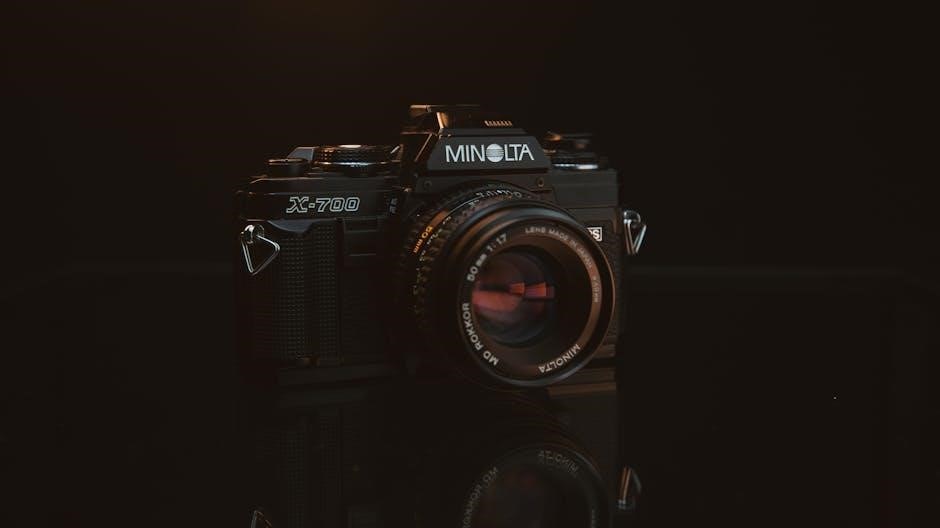
Recorded on November 22, 2025, the Minolta X-370 is primarily designed for standard 35mm film formats. This includes black and white negative film, color negative film, and color slide (transparency) film. ISO/ASA ratings from 25 to 3200 are generally compatible, though optimal results depend on lighting conditions.
While modern films work well, older film stocks may exhibit varying performance. Avoid using films with unusual backing papers or dimensions, as these could cause issues.
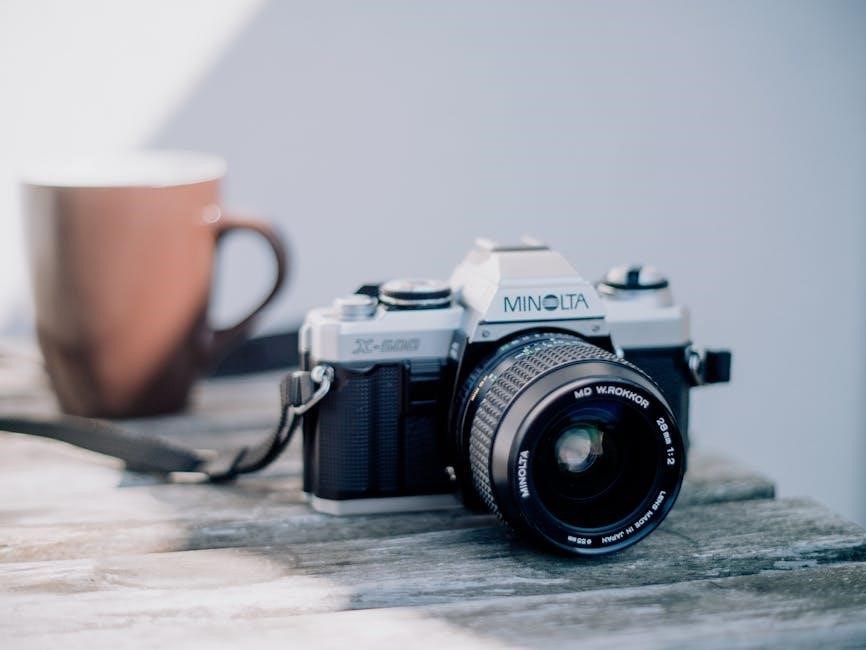
Correct Film Loading Procedure

As of November 22, 2025, begin by opening the camera back. Place the film canister into the film chamber, ensuring it seats correctly. Thread the film leader to the take-up spool, advancing slightly with the film advance lever. Confirm the film perforations engage the sprockets on both sides.
Close the camera back securely; Advance the film two or three times and check the rewind knob rotates, indicating proper loading. Note the frame counter will begin automatically.
Film Rewinding Instructions
Recorded on November 22, 2025, to rewind the film, locate the rewind crank on the camera’s top plate. Gently pull the rewind crank outward. Rotate the crank in the direction indicated by the arrow – typically clockwise – feeling for resistance.
As the film rewinds, the resistance will lessen. Continue until the film is fully retracted into the canister. Open the camera back and remove the film canister. Proper rewinding prevents light leaks and film damage.
Metering System Explained
As of November 22, 2025, the Minolta X-370 utilizes a center-weighted, match-needle metering system. Light enters the camera, activating a light sensor. This sensor powers the needle in the viewfinder, indicating exposure accuracy.
Align the needle with the center mark for correct exposure. The system prioritizes central frame metering. Understanding this system is crucial for achieving properly exposed photographs, especially in varied lighting conditions. It’s a reliable, albeit manual, approach.
Understanding the Light Meter
Recorded on November 22, 2025, the X-370’s light meter isn’t battery-dependent for basic function, but requires power for the viewfinder display. It measures light reflecting from the scene, translating it into a suggested aperture and shutter speed combination.
The meter displays as a +/- indicator and a needle. “0” signifies correct exposure. Positive values indicate overexposure, negative underexposure. Mastering meter interpretation is key to consistent results. Remember, the meter suggests; artistic intent often overrides automatic readings.
Metering Modes (Match-needle)
As of November 22, 2025, the X-370 utilizes a “match-needle” metering system. This means you adjust either the aperture or shutter speed until the needle aligns with the center mark in the viewfinder. This indicates the camera’s assessment of proper exposure.
It’s a center-weighted average metering system, prioritizing the light in the center of the frame. Understanding this bias is crucial. The needle doesn’t directly tell you the correct settings, but guides you to them through manual adjustment.
Exposure Compensation Techniques

Recorded on November 22, 2025, the X-370 lacks a dedicated exposure compensation dial. However, you can achieve similar results by mentally adjusting your settings. For example, when shooting snow, deliberately underexpose by one stop to prevent a washed-out image.
Conversely, for dark subjects, overexpose by a stop. This “guesswork” requires practice and understanding of the scene’s reflective properties. Regularly reviewing your results and adjusting accordingly is key to mastering exposure with this system.
Focusing System & Viewfinder
As of November 22, 2025, the Minolta X-370’s focusing relies on a traditional manual system. The viewfinder provides a clear, bright view of the scene, crucial for accurate focusing. It incorporates a split-image focusing aid at the center, helping achieve sharpness.
Aligning the divided image confirms critical focus. Surrounding the split-image are focusing aids, assisting with precise adjustments. The viewfinder also displays essential shooting information, like shutter speed and aperture settings, for informed decisions.
Focusing Screen Details
Recorded on November 22, 2025, the Minolta X-370’s focusing screen is a vital component for manual focusing precision. It features a central split-image rangefinder, dividing the scene into two opposing sections. Achieving sharp focus involves aligning these two images into one cohesive view.
Surrounding the split-image are microprism collars, aiding in fine-tuning focus, especially in lower light. The screen’s matte surface reduces glare and enhances contrast, improving visibility. Careful observation of these elements ensures consistently sharp photographs.
Split-Image Focusing Aid
As of November 22, 2025, the X-370’s split-image rangefinder is central to achieving accurate manual focus. This ingenious system divides the central viewfinder area into two horizontally opposing sections. When the subject is out of focus, these sections appear separated.
Rotating the focusing ring brings the two images closer together. Perfect focus is achieved when the split disappears, and a single, unified image appears. This intuitive method provides quick and reliable focusing, even in challenging lighting conditions, ensuring sharp results.
Viewfinder Information Display
Recorded on November 22, 2025, the X-370’s viewfinder presents crucial shooting data. A needle indicates exposure levels relative to the camera’s metering system. Centering the needle signifies correct exposure. (+) and (-) markings guide aperture or shutter speed adjustments.
Additionally, the viewfinder displays focusing aids like the split-image rangefinder. Brightness indicators assist in low-light situations. This comprehensive display allows for informed shooting decisions, ensuring properly exposed and sharply focused photographs, even during fast-paced action.
Using Lenses with the X-370
As of November 22, 2025, the Minolta X-370 utilizes the Minolta MD mount, offering compatibility with a vast range of lenses. These lenses provide excellent optical quality and manual control. Adapters exist for using lenses from other mounts, like SR, but may limit functionality.
Proper lens care is vital; avoid dropping or subjecting lenses to extreme temperatures. Regularly clean the glass with a lens cloth. Maintaining lenses ensures optimal performance and longevity, maximizing the X-370’s photographic potential.
Minolta MD Mount Compatibility
Recorded on November 22, 2025, the Minolta X-370’s MD mount is a cornerstone of its versatility. It accepts all Minolta MD and MC lenses without adapters, offering full mechanical and optical coupling. This ensures accurate aperture control and focusing.
Later MD lenses feature a more robust mount. While MC lenses function perfectly, MD lenses are generally preferred for their durability. Compatibility extends to third-party lenses built for the MD mount, broadening your creative options significantly.
Adapting Other Lens Mounts
As of November 22, 2025, expanding beyond the native Minolta MD mount is achievable with adapters. Numerous adapters exist for Canon FD, Olympus OM, Pentax K, and Nikon F lenses, though functionality varies. Adapters typically allow manual aperture control and focusing, sacrificing automatic features.
Carefully research adapter quality; cheaper options may introduce play or affect image quality. Back-focus adjustments might be necessary for optimal sharpness. Adapting lenses opens a world of possibilities, but requires understanding the limitations.

Lens Care and Maintenance
Recorded on November 22, 2025, proper lens care is crucial for preserving image quality. Regularly use a blower to remove dust. For fingerprints, employ lens cleaning fluid and microfiber cloths, applying gentle circular motions. Avoid harsh chemicals or abrasive materials.
Store lenses with caps on, in a dry, dust-free environment. Inspect elements periodically for fungus or haze. Professional cleaning is recommended for internal issues. Consistent care ensures longevity and optimal performance of your Minolta lenses.
Troubleshooting Common Issues
As of November 22, 2025, several issues can arise with the Minolta X-370. Shutter problems often stem from old lubricants; avoid self-repair and seek professional servicing. Metering errors may indicate weak batteries or a faulty meter – test with a known good battery first.
Film transport issues could be caused by debris or a worn advance mechanism. Carefully inspect and clean the film chamber. If problems persist, consult a qualified repair technician for diagnosis and resolution.
Shutter Problems & Solutions
Recorded on November 22, 2025, common shutter issues with the Minolta X-370 include slow speeds or complete failure. Often, this results from dried-out lubricants within the mechanism. Do not attempt disassembly; it requires specialized tools and knowledge.
Instead, seek a qualified camera repair technician. They can clean, lubricate, and adjust the shutter for optimal performance. A sticky shutter curtain can sometimes be gently exercised, but professional intervention is highly recommended to prevent further damage.
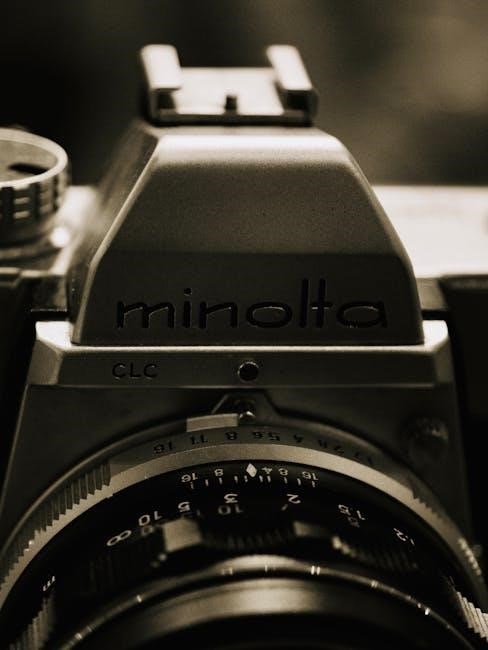
Metering Errors & Fixes
As of November 22, 2025, inaccurate readings from the Minolta X-370’s match-needle metering system often stem from aging batteries. Always begin by replacing the PX28 battery with a fresh one, ensuring correct polarity. If the issue persists, check the light seals for deterioration, as light leaks can affect readings;
A dirty viewfinder window can also cause errors. Gently clean it with a microfiber cloth. If problems continue, professional calibration by a camera technician is advised for accurate exposure.
Film Transport Issues
Recorded on November 22, 2025, difficulties with film advance or rewind on the Minolta X-370 frequently relate to improper film loading. Ensure the film leader is correctly engaged with the take-up spool. If the film isn’t advancing, check for obstructions within the film chamber.
A jammed rewind crank suggests the film may be tangled. Gently attempt to loosen it. Avoid forcing anything. If issues persist, professional servicing is recommended to prevent damage to the delicate internal mechanisms.
Maintenance and Care
As of November 22, 2025, preserving your Minolta X-370 requires diligent care. Regularly clean the camera body with a soft, dry cloth to remove dust and fingerprints. Avoid harsh chemicals or solvents. For the lens, use dedicated lens cleaning fluid and microfiber cloths.
Store the camera in a cool, dry place, away from direct sunlight and moisture. A camera bag offers excellent protection. Periodic professional servicing ensures optimal performance and longevity of this classic photographic tool;
Cleaning the Camera Body
As of today, November 22, 2025, maintaining the Minolta X-370’s exterior is crucial. Use a soft, lint-free cloth to gently wipe down the body, removing dust and smudges. Avoid abrasive cleaners or solvents, as they can damage the finish.
For stubborn marks, lightly dampen the cloth with distilled water. Pay attention to crevices where dust accumulates. Regularly cleaning prevents buildup and ensures the camera’s aesthetic appeal and functional integrity are preserved for years to come.
Lens Cleaning Procedures
Recorded on November 22, 2025, proper lens care is vital for optimal image quality with your Minolta X-370. Begin with a blower brush to remove loose dust and debris. Then, use lens cleaning tissue and a dedicated lens cleaning solution – never household cleaners!
Apply a small amount of solution to the tissue, not directly to the lens. Gently wipe in a circular motion. Inspect for streaks and repeat if necessary. Store lenses with caps on to prevent dust accumulation.

Storage Recommendations
As of November 22, 2025, safeguarding your Minolta X-370 ensures its longevity. Store the camera body and lenses separately in a cool, dry place, away from direct sunlight and extreme temperatures. Utilize a camera bag or case for protection against dust and impacts.
Consider using silica gel packets to absorb moisture, preventing fungus growth. Remove batteries during prolonged storage to avoid corrosion. Regular use is also beneficial for maintaining functionality!
Resources & Further Learning
As of November 22, 2025, numerous online resources enhance your Minolta X-370 experience. Explore dedicated user forums for troubleshooting and shared knowledge. Digital copies of the original camera manual are readily available online, offering detailed instructions.
Websites specializing in vintage cameras often provide guides and repair information. Consider joining Minolta photography groups on social media for community support. Remember to verify information from multiple sources for accuracy!
Online Manuals & Guides
As of today, November 22, 2025, accessing the Minolta X-370 manual digitally is remarkably easy. Several websites archive original manuals in PDF format, offering a convenient alternative to the physical copy. These guides detail every function, from loading film to utilizing the metering system.

Furthermore, independent photography blogs and websites provide supplementary guides, often with illustrative photos and step-by-step instructions. These resources can clarify complex features and offer practical shooting tips.
Minolta X-370 User Forums
Today, November 22, 2025, dedicated online forums serve as invaluable hubs for Minolta X-370 users. These communities foster knowledge sharing, troubleshooting assistance, and a collective passion for this classic camera. Members frequently post questions, share repair experiences, and offer advice on lens compatibility.
Experienced users often provide detailed responses, clarifying nuances of the camera’s operation and offering solutions to common issues. These forums are a dynamic resource, constantly updated with fresh insights.
Repair Services & Information
As of today, November 22, 2025, locating reliable repair services for the Minolta X-370 requires diligent research. Several specialized camera repair shops offer expertise in servicing classic film cameras. Online resources list technicians with proven track records and positive customer feedback.
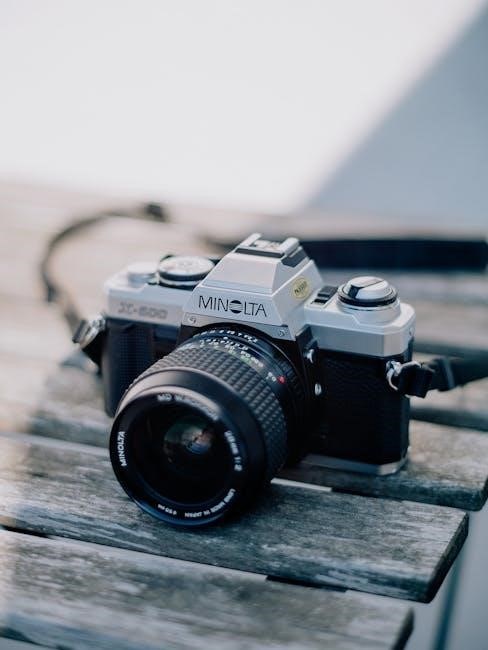
Common repairs include shutter servicing, light meter calibration, and film transport mechanism adjustments. Before sending your camera, obtain a repair estimate and inquire about turnaround times. DIY repair information is limited, caution is advised.
